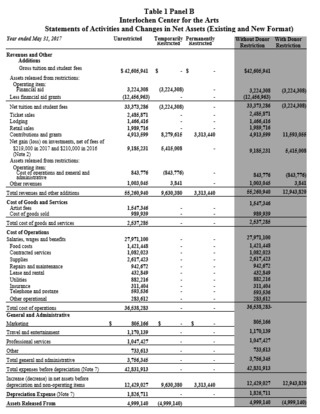
The par value of a company’s stock can be found in the Shareholders’ Equity section of the balance sheet. The only financial effect of a no-par value issuance is that any equity funding generated by the sale of no-par value stock is credited to the common stock account. Conversely, funds from the sale of par value stock are divided between the common stock account and the paid-in capital account. On the other hand, if the market price of the stock falls below the par value, the company may be liable to shareholders for the difference. Most companies opt to set a minimum par value for their stock shares to circumvent this scenario. Be sure to calculate your own yields-at-maturity or effective dividend payment rates to determine if the security you’re buying is a good deal for you.
- As with bonds and preferred stock, the final market value of a common stock has no relationship to its par value.
- Many companies report par values that fall between a penny and a nickel.
- Common stock is issued with a par value, but it plays a negligible role in common stock trading for the average consumer.
- When a corporation is formed, the articles of incorporation must set a par value for its common stock, which all shareholders must pay to own each share in the newly incorporated company.
- All this just scratches the surface of par value—as dismissive as many people are about the significance of par value, there are numerous ways, small and large, that par value can affect your business.
Today, companies will typically issue common stock with no par value. If a jurisdiction requires the company to issue stock with a par value, the company will usually select the smallest currency value in that geography. For example, a company might issue common stock with a par value of $0.01 in the United States. The value of a share is a nominal value assigned by the company at the time of stock issue. So, it is essential to understand the value of a share, but it has no impact on its equity value or market value. Company Fellow Ltd issues 5000 shares with a value of $10 per share.
BUS103: Introduction to Financial Accounting
A bond selling below par means the interest you would receive from the investment is higher than the coupon rate. While most bonds are issued at their par value, this is not necessarily a requirement. Depending on the economy’s current interest rates, a bond can get issued at a discount or a premium.
Oppenheimer Holdings Inc. Announces Preliminary Results of … – PR Newswire
Oppenheimer Holdings Inc. Announces Preliminary Results of ….
Posted: Thu, 29 Jun 2023 12:00:00 GMT [source]
The par value of a bond will either be its face value or its value upon maturation. The intent behind the par value concept was that prospective investors could be assured that an issuing company would not issue shares at a price below the par value. If the coupon rate equals the interest rate, the bond will trade at its par value. If interest rates rise, the price of a lower-coupon bond must decline to offer the same yield to investors, causing it to trade below its par value.
Par Value of Common Stock
Ultimately, a share is worth what an investor is willing to pay for it. And over time, you slowly begin to realize that even if par value is an outdated concept, your corporation’s par value has real—and sometimes significant—effects on your business. Common stock valuation is an essential factor in determining a stock’s price. Learn the different types of growth, how growth is determined, and why growth expectations significantly affect stock valuations. The face value (FV) on a bond is particularly important for calculating the yield to maturity (YTM).
What is the difference between preferred stock and common stock?
The main difference between preferred and common stock is that preferred stock gives no voting rights to shareholders while common stock does. Preferred shareholders have priority over a company's income, meaning they are paid dividends before common shareholders.
Therefore, the company will not have a future obligation to shareholders should its stock price decline. A share of stock in a company may have a par value or no-par value. These categories are both pretty much a historical oddity and have no relevance to the stock’s price in the market. If you paid more than par value to buy a bond in the secondary market, the effective interest rate you’d earn on the bond would be lower than the coupon. If you paid less than par value for a bond, the effective interest you’d earn would be higher than the coupon. The use of a par value may confuse some investors because the par value
usually does not conform to the market value.
Chapter 14: Common And Preferred Stock
If the stock has no par value, then “no par value” is stated on the certificate instead. If market interest rates fall to 3%, the value of the bond will rise and trade above par since the 4% coupon rate is more attractive than 3%. Par value, also known as nominal or original value, is the face value of a bond or the value of a stock certificate, as stated in the corporate charter. This takes the burden of research off of you and makes individual par values and interest rates less relevant as you benefit from the overall growth of a whole sector of stocks or bonds. In many cases, corporations will want to assign a par value so that an investment (whether it be funds or services) is required in order to own a share in the company.
The investor decides to accept this proposal rather than go to the trouble of trying to sell the land. For example, Kellogg discloses a par value of $0.25 for its common stock, which is actually bookkeeper duties quite high. Many companies report par values that fall between a penny and a nickel. The balance sheet for Barnes & Noble shows a par value for its common stock of one-tenth of a penny.
The difference between par and no par value stock
Some bonds are sold at a discount, for instance, and pay back their par value at maturity. In any case, the fixed par value is used to calculate the bond’s fixed interest rate, which is referred to as its coupon. The par value of a security is the original face value when it is issued. While bonds, common stock and preferred stock all carry a par value, it works differently for each type of security.
- If this stock was not selling on a stock exchange, fair value might not be apparent.
- Existing and prospective investors could be assured that the issuer cannot legally sell shares at a price lower than the par value.
- On the other hand, if the market price of the stock falls below the par value, the company may be liable to shareholders for the difference.
- People who wish to apply to form a corporation must comply with government requirements.
- If interest rates rise, the price of a lower-coupon bond must decline to offer the same yield to investors, causing it to trade below its par value.
- Similar to the coupon rate and par value of bonds, corporations issue preferred stock with a dividend rate calculated as a percentage of the face value.
The corporation issuing the stock will debit Cash for $25.00 and will credit Common Stock for $0.01 and will credit Additional Paid-in Capital for $24.99. If the business fails six months later and owes creditors $5,000, the creditors could review the accounting statements to ensure the business was fully capitalized. In accounting, the par value allows the company to put a de minimis value for the stock on the company’s financial statement. Par value is also used to calculate legal capital or share capital. Par value is a primary component of fixed-income securities such as bonds and represents the value of a contractual agreement, a loan, between the issuing party and the bondholder. The issuer of a fixed-income security is liable to repay the lender the par value on the maturity date.
What is the par value of common stock?
The capitalization target is readily configured if the company will set a value for each stock offered. Shares of stock sold at a price above the par value would result in additional paid-in capital, reflected in the books of the company. Although the fluctuating market price of stocks has no effect on the books, par value has a legal bind on part of the company to its investors – no shares will be sold below that price.

What is par value of common and preferred stock?
What is Par Value for Preferred Stock? The par value of a share of preferred stock is the amount upon which the associated dividend is calculated. Thus, if the par value of the stock is $1,000 and the dividend is 5%, then the issuing entity must pay $50 per year for as long as the preferred stock is outstanding.




